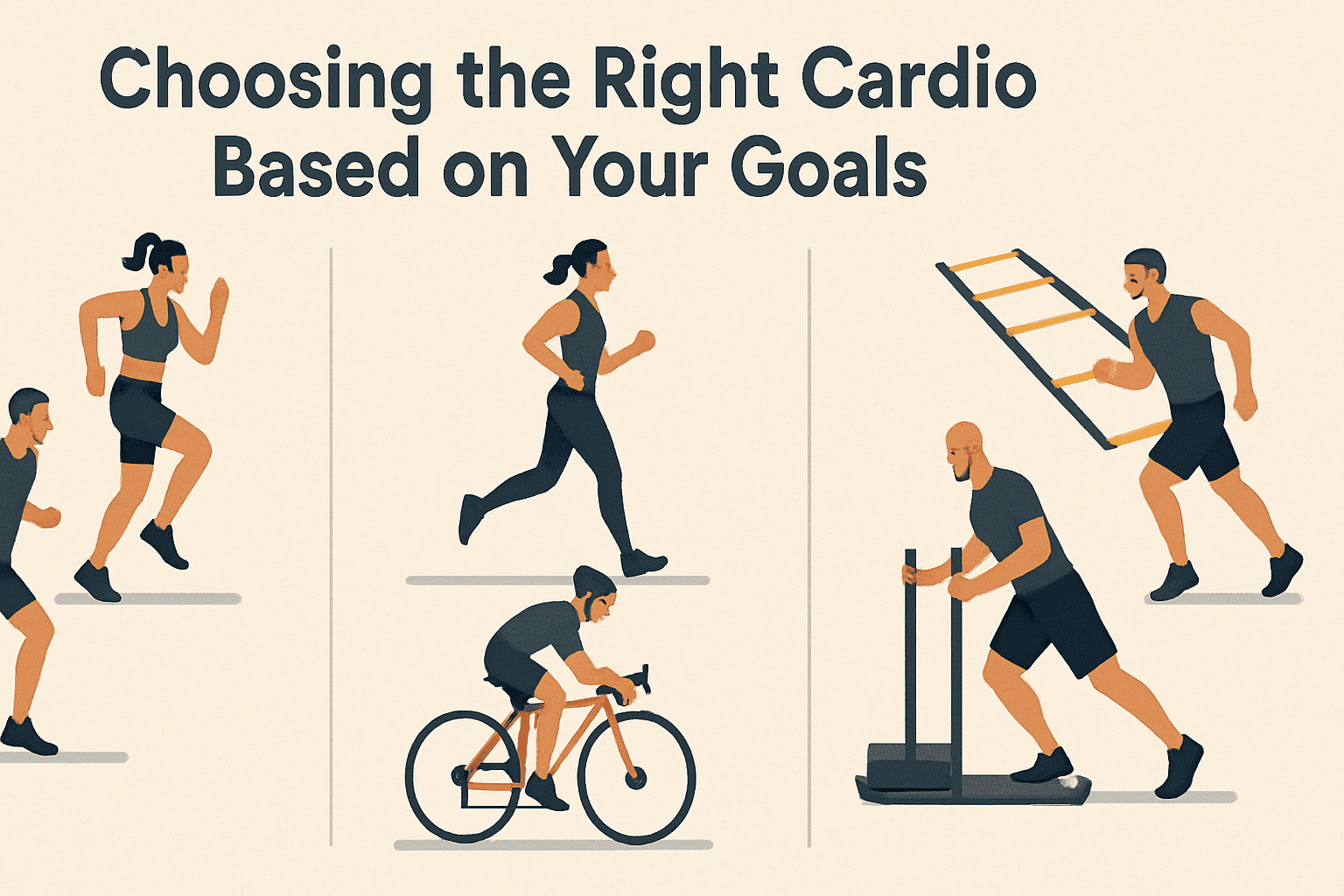There is an undeniable allure in cardio workouts that go beyond routine repetition and tap into something joyful and motivating. For those striving to improve their cardiovascular health, boost endurance, or lose weight, the right cardio workout plan can be more than just effective—it can be exhilarating. In this article, we explore expert-approved strategies to make cardio fun, sustainable, and powerful, with a special focus on medically accurate insights and a reader-friendly narrative grounded in the principles of EEAT: Experience, Expertise, Authoritativeness, and Trustworthiness.
You may also like: Smart Nutrition Choices for a Healthier Lifestyle: What to Know About Whole Grain Rice and Whole Wheat Rice
Understanding the Importance of Cardiovascular Fitness
Before diving into the specifics of fun cardio routines, it is important to understand why cardiovascular fitness matters. Cardio exercises stimulate your heart, lungs, and circulatory system, helping your body use oxygen more efficiently. As a result, regular cardiovascular activity reduces the risk of heart disease, improves metabolic function, and supports mental clarity and emotional well-being. According to the American Heart Association, adults should aim for at least 150 minutes of moderate-intensity aerobic activity per week. The good news is that these sessions don’t have to feel like a chore.
In fact, fun cardio workouts are a compelling way to transform how people view physical activity. When enjoyment is part of the equation, consistency follows, and consistency is the secret to lasting health improvements. Whether you’re engaging in a structured cardio workout routine at the gym or experimenting with cardio workouts at home for weight loss, the emphasis on enjoyment can make all the difference.

What Are Some Cardio Exercises That Actually Feel Fun?
A key reason people abandon their cardio routine is boredom. Repetition without variation leads to stagnation, not just physically but mentally. Fortunately, there are numerous examples of cardio activities that are enjoyable and effective. Dancing, for example, is a highly effective aerobic workout. Zumba, hip hop dance, and even freestyle movement to your favorite music can elevate your heart rate while lifting your spirits.
Jump rope routines are another fun cardio exercise option that combines coordination, rhythm, and cardiovascular benefits. Just 10 minutes of moderate to intense jump rope training can burn as many calories as 30 minutes of jogging. Similarly, using a hula hoop can engage your core while also offering a playful approach to movement. These are just a few creative cardio workout examples that prove cardio doesn’t have to feel like punishment.

Exploring Different Cardio Options for Every Personality
One of the most common misconceptions about cardio is that it must involve machines or structured classes. However, the definition of cardio is broader and more inclusive than many realize. Hiking, rollerblading, swimming, or even brisk walking with intervals are all forms of functional cardio exercises. These activities support heart health while integrating naturally into everyday life.
A successful cardio workout program is tailored to personality, lifestyle, and goals. For the high-energy individual, circuit training cardio exercises can provide a dynamic and fast-paced approach that minimizes downtime and maximizes intensity. This type of cardio circuit exercise is ideal for those who crave variety and want to target multiple muscle groups while elevating their heart rate.
By contrast, those who prefer a steady, meditative rhythm may enjoy long-distance running, rowing, or cycling—activities that allow for deeper mental engagement while supporting cardiovascular endurance. Designing a cardio exercise plan that suits your temperament can lead to improved adherence and better results.
How to Design a Cardio Workout Plan That Works for You
Creating a cardio workout plan requires thoughtful consideration of your current fitness level, long-term goals, and time availability. A well-balanced plan should include a mix of low-, moderate-, and high-intensity sessions to ensure progressive overload without burnout. For instance, your weekly fitness cardio plan might alternate between steady-state cardio days, like 45 minutes of cycling, and quick cardio routines such as 20-minute HIIT sessions.
When working out cardio on designated days, remember to balance your cardio day exercises with proper recovery and cross-training. A cardio day workout might focus on cardiovascular exercises in the gym, such as treadmill sprints, stair climbing, or rowing intervals. Meanwhile, on recovery days, light movement like yoga or walking can promote blood flow and muscle repair.
Additionally, each cardio training plan should account for variety to prevent adaptation. That might mean incorporating a cardio gym programme twice a week, while adding cardio workouts at home for weight loss on alternate days. The flexibility of mixing gym and home-based workouts ensures accessibility without compromising results.

The Science Behind Cardio Exercises for Weight Loss
Cardio exercises for weight loss are widely promoted, but not all approaches are equally effective. Scientific studies have demonstrated that high-intensity interval training (HIIT) can be particularly useful in burning fat while preserving lean muscle mass. HIIT involves alternating between intense bursts of effort and brief recovery periods, allowing for more calories burned in less time.
Cardio circuit exercises, a subset of HIIT, combine aerobic movements with strength-building elements. This approach not only boosts cardiovascular endurance but also creates an afterburn effect, known as excess post-exercise oxygen consumption (EPOC), which continues to burn calories after the session ends. For those with limited time, quick cardio routines using circuit formats can be a game-changer.
However, not everyone enjoys high-intensity formats. That’s where fun cardio routines come into play. A cardio exercise routine for weight loss doesn’t have to be grueling. It can include dancing, kickboxing, or cardio-focused group classes that feel more like a social event than a workout. The best cardio workout plan is the one you actually look forward to.
Making the Gym Experience Engaging with Cardio
Many people associate the gym with monotony, especially if they stick to the same treadmill routine. But with a little creativity, the gym can be a hub for good cardio exercises that are both fun and functional. For example, circuit training cardio exercises can be performed using resistance machines, free weights, and bodyweight movements in sequence to keep the heart rate elevated.
Those seeking variety can alternate between stationary bikes, elliptical machines, and rowing equipment within a single cardio gym programme. These tools offer unique cardiovascular benefits and prevent the kind of repetition that leads to mental fatigue. Additionally, many gyms now offer interactive cardio workouts, such as virtual cycling classes or dance-based fitness sessions, which add an element of entertainment.
The key is to move beyond the mindset of cardio as a chore. Cardiac exercise in the gym becomes more appealing when structured around curiosity and play. Exploring different cardio machines and creating new routines based on your mood and energy level can reignite your motivation and commitment to regular exercise.

Maximizing Motivation with Fun Cardio Drills and Games
Motivation often fades when routines become predictable, but injecting playfulness into your cardio routine can renew your enthusiasm. Fun cardio drills, such as agility ladders, cone drills, or shuttle runs, turn training into a game. These drills also improve coordination and balance, which are essential for overall athletic performance.
Incorporating team-based or competitive elements into your cardio workout routine can further boost engagement. Partner relays, timed challenges, or fitness-based scavenger hunts are excellent ways to combine movement with social interaction. These activities blur the line between exercise and recreation, making cardio feel like a reward rather than a responsibility.
For those training solo, digital apps and virtual platforms now offer gamified cardio training plans, where users earn points or rewards for completing challenges. Whether you’re striving to complete a streak of quick cardio sessions or aiming to climb a virtual leaderboard, these systems provide accountability and a sense of progress that fuels motivation.
Building a Sustainable Fitness Cardio Plan for Long-Term Success
Longevity in fitness requires sustainability. A cardio routine that feels forced or overly rigid is unlikely to endure. Instead, a flexible, personalized cardio exercise plan ensures both physical progress and emotional satisfaction. The ideal approach integrates various types of cardio, allowing for rotation between low-impact sessions and high-energy routines.
Consider mapping out a month-long cardio workout program with built-in flexibility. This might include three structured sessions per week and two optional “fun days” where you explore different cardio like trampoline workouts, hiking, or dance classes. By creating space for spontaneity, your fitness cardio plan becomes something to look forward to, not just endure.
Adaptability is also key. As your fitness level evolves, so should your cardio training plans. Gradually increasing duration, intensity, or complexity ensures continued improvement while preventing plateaus. Tracking your progress through journals, wearable fitness devices, or apps can provide tangible motivation and help you fine-tune your cardio exercise routine for weight loss or endurance enhancement.

Choosing the Right Cardio Based on Your Goals
Your choice of cardio should be directly influenced by your personal goals. For example, if fat loss is your primary aim, combining steady-state cardio with circuit training cardio exercises may deliver optimal results. On the other hand, if you’re an endurance athlete preparing for a race, longer aerobic sessions are essential.
Cardio day exercises can be organized based on these objectives. A cardio workout plan for fat loss might focus on quick cardio circuits and high-intensity sprints, while a cardiovascular workout plan for stamina could emphasize time-on-feet through activities like trail running or indoor cycling. Identifying your goal helps you filter through different cardio methods and select the ones that align with your desired outcome.
It’s also worth noting that preferences evolve. What started as a weight loss journey may transition into a love for functional cardio exercises that emphasize strength and movement quality. Re-evaluating your plan every few months ensures it remains relevant and exciting.

Home-Based Cardio Workouts That Deliver Results
Not everyone has access to a gym or prefers the public setting. Thankfully, there are numerous cardio workouts at home for weight loss that are just as effective as gym-based routines. With minimal equipment or even just your bodyweight, you can design a comprehensive cardio workout program that suits your environment and schedule.
Bodyweight circuits, shadowboxing, stair climbing, or following dance fitness videos online are excellent examples of cardio activities you can do at home. These workouts are not only convenient but also customizable, allowing you to scale up intensity as your fitness improves. Creating a space in your home that feels inviting can encourage more frequent sessions and reduce barriers to entry.
Incorporating variety is especially important for home training. Alternating between different cardio formats, like low-impact yoga flows one day and a quick cardio routine the next, keeps your mind engaged while providing the physical benefits of a well-rounded regimen. With creativity and consistency, cardio workouts at home for weight loss can rival the results of any gym-based plan.
The Role of Functional Cardio Exercises in Athletic Training
Athletes and active individuals benefit from functional cardio exercises that mimic real-life movement patterns. These exercises improve not just endurance but also agility, coordination, and strength. Examples include sled pushes, farmer’s carries, and agility ladder drills, which combine aerobic output with practical skill development.
Incorporating these into your cardio workout program ensures that your training supports daily tasks and athletic performance. This approach aligns with the concept of training smarter, not just harder. By targeting multiple systems within a single session, functional cardio exercises maximize time efficiency and enhance overall resilience.
Whether you are an athlete or a weekend warrior, these types of movements can reduce injury risk by improving neuromuscular control. They also create a sense of purpose, as each session contributes directly to improved real-world function, making your cardio routine both meaningful and effective.

Quick Cardio Routines for Busy Days
Time constraints are one of the most commonly cited barriers to exercise. However, a lack of time doesn’t have to mean skipping your cardio day. Quick cardio routines can be just as effective as longer sessions when structured correctly. Tabata training, for instance, involves 20 seconds of maximal effort followed by 10 seconds of rest, repeated for four minutes per exercise.
These short sessions are ideal for maintaining momentum during a hectic schedule. They can include bodyweight movements like burpees, high knees, jumping jacks, or mountain climbers. The key is to maintain intensity during work intervals to elevate your heart rate and stimulate cardiovascular adaptation.
Over time, these brief yet powerful sessions accumulate meaningful results. Consistently performing a 15-minute cardio workout routine several times per week can contribute significantly to improved endurance, fat loss, and mental health. Quick cardio options make it possible to integrate movement into even the busiest lifestyle.
Frequently Asked Questions (FAQ): Fun and Effective Cardio Training for Endurance and Weight Loss
1. How can I make cardio workouts more mentally stimulating?
To make cardio training mentally engaging, consider layering cognitive challenges into your routine. For instance, during a cardio workout routine, you might alternate movement patterns, memorize sequences, or practice dual-task drills like solving math problems while jumping rope. These techniques tap into neuroplasticity and help enhance both physical and mental performance. Functional cardio exercises that incorporate balance and coordination, such as agility drills, further engage your brain while improving athleticism. Integrating these elements into your cardio workout plan not only improves endurance but also keeps boredom at bay, which is crucial for long-term adherence to any fitness cardio plan.
2. What are some unconventional cardio exercises that still deliver serious results?
Beyond the standard treadmill and bike options, there are many examples of cardio activities that are both unconventional and highly effective. Animal flow, for example, is a ground-based movement style that combines strength and cardiovascular output in one fluid session. Rebounding, or mini-trampoline training, is another great alternative that offers low-impact, full-body cardio with joint-friendly benefits. These types of different cardio options challenge the body in fresh ways and can be included in a cardio day workout for added variety. When working out cardio through these novel movements, you stimulate new muscle groups and prevent stagnation, enhancing the overall effect of your cardio exercise plan.
3. How do I prevent burnout with circuit training cardio exercises?
While circuit training cardio exercises are excellent for efficiency and intensity, they can lead to mental and physical fatigue if overused. To avoid burnout, alternate high-intensity days with low-impact sessions, such as swimming or yoga, within your cardio workout program. You can also periodize your cardio routine, using structured training blocks that rotate between endurance-building phases and recovery periods. On cardio day exercises, consider switching modalities—use rowing machines one week and sled pushes the next—to prevent overreliance on specific muscle groups. This balanced approach ensures that your cardio training plans remain effective and sustainable without draining your motivation.
4. How can fun cardio routines benefit people who struggle with exercise consistency?
Fun cardio workouts are especially valuable for individuals who find it hard to stick to a schedule. When cardio feels like play instead of punishment, it reduces psychological resistance and enhances intrinsic motivation. Activities like group dance classes, trampoline fitness, or even exergaming (fitness video games) can reignite a person’s excitement for movement. These fun cardio routines also support community-building and social interaction, two factors that correlate strongly with long-term habit formation. By regularly incorporating fun cardio exercises into a fitness cardio plan, you’re more likely to stay consistent and see meaningful improvements over time.
5. What are some cardio workout examples that support joint health?
Protecting joint health while maintaining cardiovascular fitness requires thoughtful exercise selection. Aquatic workouts, elliptical sessions, and incline walking are excellent low-impact cardio workout examples that reduce wear and tear on the knees and hips. You might also try cycling or seated rowers, both of which are commonly included in a cardio gym programme aimed at preserving mobility. For those dealing with chronic pain or post-rehabilitation, incorporating these good cardio exercises at the gym into your cardio workout plan can enhance circulation and reduce inflammation without exacerbating joint stress. If working out cardio causes discomfort, consult with a physical therapist who can help modify movements for safer execution.
6. How do I adjust my cardio exercise routine for weight loss as I get stronger?
As your fitness improves, your body becomes more efficient, which can reduce the calorie-burning effect of a once-challenging routine. To maintain results, adjust your cardio exercise routine for weight loss by increasing intensity, volume, or complexity. You might shift from steady-state jogging to interval running or incorporate resistance bands into your cardio circuits. Your evolving cardio routine should continue to push your threshold while respecting your recovery needs. This progression is critical in any long-term cardio workout plan and ensures that your cardiovascular and metabolic systems remain challenged as you adapt.
7. Are quick cardio routines really enough to make a difference?
Yes, quick cardio routines can be highly effective when designed with intention and executed at sufficient intensity. The key lies in optimizing work-to-rest ratios and targeting multiple muscle groups within a condensed timeframe. For instance, a 15-minute EMOM (Every Minute on the Minute) workout involving burpees, high knees, and squat jumps can be more taxing than a 45-minute walk. Incorporating quick cardio into your week adds flexibility to your fitness cardio plan and reduces the risk of skipping sessions due to time constraints. While they shouldn’t replace all forms of cardio, quick sessions serve as valuable tools within well-rounded cardio training plans.
8. What are the benefits of combining strength training with cardiovascular exercises in the gym?
Blending resistance work with cardiovascular exercises in the gym yields synergistic benefits. When combined, they improve both muscular and aerobic capacity, making your workouts more time-efficient. For example, cardio circuit exercises that pair kettlebell swings with bike sprints target strength, power, and endurance simultaneously. This hybrid method can increase calorie expenditure, boost heart health, and support better functional movement patterns. If your cardio gym programme includes these compound training days, ensure you alternate them with rest or active recovery to avoid overtraining.
9. How can cardio workouts at home for weight loss be optimized for small spaces?
You don’t need a large area to complete an effective cardio session. High-knee drills, jump squats, shadowboxing, and modified burpees can all be done in compact environments. When creating a cardio workout routine at home, use vertical space (like staircases) or incorporate furniture for bodyweight dips and step-ups. Interval training works especially well in tight quarters, as you can perform high-intensity moves in short bursts followed by rest periods. Rotating between different cardio drills also prevents the space from feeling restrictive and helps you stay engaged during your cardio workouts at home for weight loss.
10. What role does variety play in an effective cardio exercise plan?
Variety is essential in preventing physical plateaus and mental fatigue. Rotating between steady-state, interval, and functional cardio exercises challenges different energy systems and improves overall resilience. Moreover, mixing in activities such as dance, hiking, rowing, and fun cardio drills allows the body to recover while still progressing. A well-rounded cardio exercise plan benefits from diversity because it cultivates broader athleticism and decreases the likelihood of overuse injuries. By consistently cycling through different cardio formats, your cardio routine stays fresh, effective, and enjoyable—key ingredients for long-term health and performance.
Conclusion: Redefining Cardio with Joy, Variety, and Science
Ultimately, the most effective cardio workout plan is the one you enjoy enough to stick with. By exploring a diverse range of fun cardio exercises and tailoring them to your goals, preferences, and schedule, you can unlock the full benefits of cardiovascular training without the dread. Whether you’re pushing through circuit training cardio exercises at the gym or dancing in your living room with cardio workouts at home for weight loss, every step you take is an investment in your long-term well-being.
From quick cardio routines that fit into a busy day to functional cardio exercises that improve real-world performance, cardio can be both purposeful and pleasurable. By embracing variety and staying attuned to your body’s feedback, your cardio exercise plan can evolve into a dynamic, empowering lifestyle habit. Cardio doesn’t have to be boring, punishing, or repetitive—it can be one of the most energizing, satisfying parts of your week. When your cardiovascular journey is rooted in joy and intention, every beat of your heart becomes a celebration of movement and health.
Was this article helpful? Don’t let it stop with you. Share it right now with someone who needs to see it—whether it’s a friend, a colleague, or your whole network. And if staying ahead on this topic matters to you, subscribe to this publication for the most up-to-date information. You’ll get the latest insights delivered straight to you—no searching, no missing out.
Further Reading:
A Trainer’s 4-Week Workout Plan to Jump-Start Weight Loss

